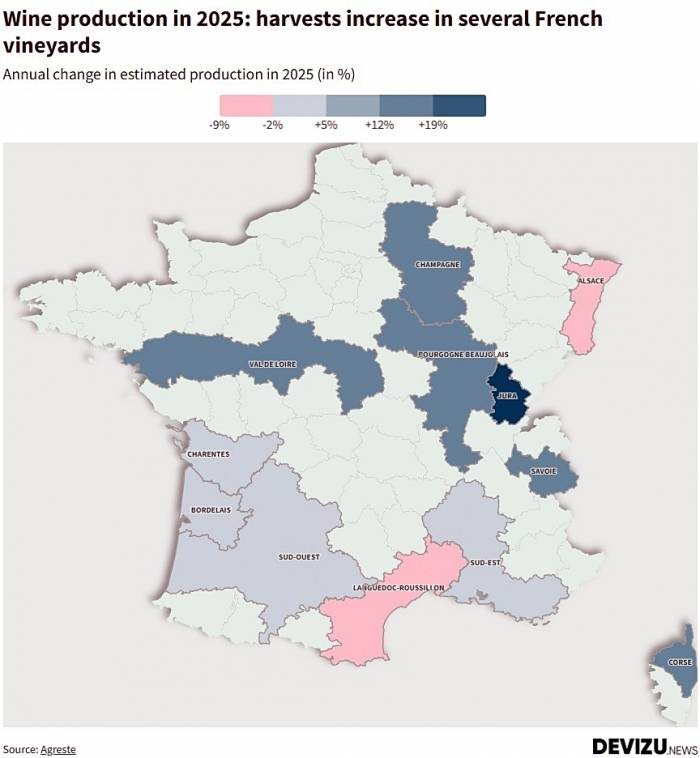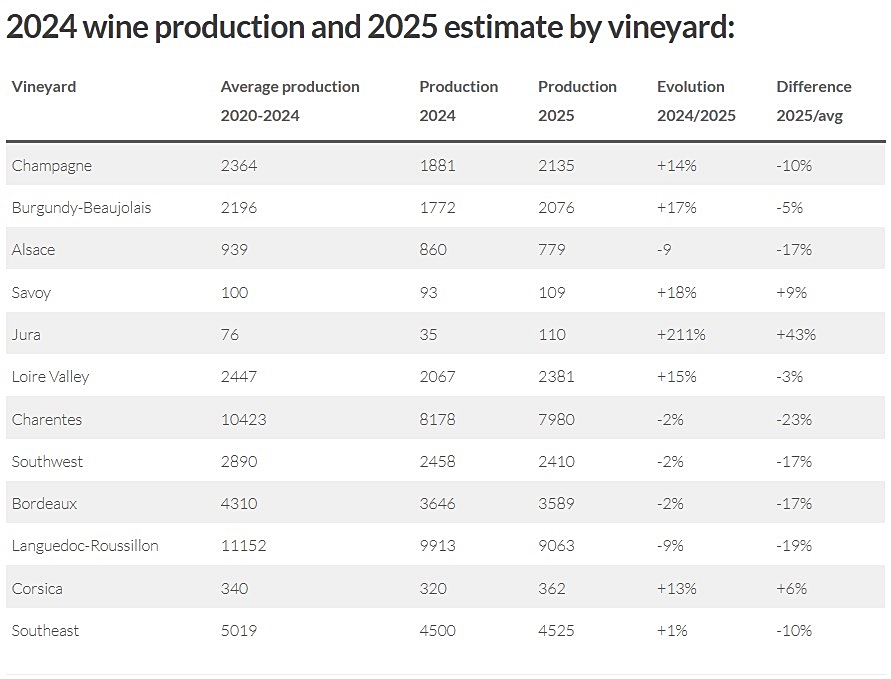French Wine Production to Drop 1% in 2025, Remaining 16% Below Five-Year Average
Heatwaves, drought, and vineyard removals drive output down to 36 million hectoliters, with regional disparities and climate challenges persisting.
2025-10-21

French wine production in 2025 is expected to remain at a low level, with estimates pointing to around 36 million hectoliters, according to figures released by Agreste, the statistics service of the French Ministry of Agriculture. This marks a 1% decrease compared to last year and keeps production well below the five-year average of 42.9 million hectoliters.
The main factors behind this subdued output are the heatwave and drought that hit France during August. These weather conditions accelerated grape ripening but prevented the berries from reaching their usual size, resulting in smaller grapes with less juice. September rains arrived too late to reverse the impact. In addition, thousands of hectares of vineyards were uprooted in several regions, further reducing potential yields.
Despite these challenges, some segments of French wine production have shown resilience. Wines with Protected Designation of Origin (AOP) are expected to see a 5% increase in output, reaching 15.9 million hectoliters. However, wines with Protected Geographical Indication (IGP) are projected to decline by 6% to 10 million hectoliters, while wines destined for spirits such as Cognac and Armagnac are expected to remain stable at around 7.7 million hectoliters.

The situation varies significantly across France’s wine regions. Languedoc-Roussillon, the country’s largest wine-producing area by volume, is forecast to experience a sharp drop of 9%, bringing production down to about 9 million hectoliters. The region was hit hard by heat, drought, and mildew, and saw the removal of approximately 10,000 hectares of vines.
In the Charentes region, which is known for its role in Cognac production, output is expected to fall slightly by 2% to 8 million hectoliters after a steep decline of 23% in 2024. Bordeaux and the South-West will also see a modest decrease of 2%, following significant losses last year due to similar weather conditions and vineyard removals.
The South-East region is expected to maintain stable production at around 4.5 million hectoliters. Champagne stands out as an exception this year: its harvest was completed more quickly than usual due to early ripening, leading to a 14% increase in production compared to last year. However, this figure remains about 10% below the five-year average for the region.
Burgundy and Beaujolais present a mixed picture. Burgundy is set for a strong rebound with a projected increase of 45%, while Beaujolais faces a sharp decline of 32%. The Loire Valley is also expected to see growth, with production rising by 15% year-on-year to reach 2.4 million hectoliters.
Other regions such as Alsace and Corsica show smaller changes: Alsace is forecast to see a decrease in output, while Corsica expects a modest increase.
The overall stabilization at a low level reflects ongoing challenges for French wine producers as they adapt to changing climate conditions and structural adjustments within the industry. The combination of extreme weather events and strategic vineyard reductions continues to shape the landscape of French viticulture in 2025.
Founded in 2007, Vinetur® is a registered trademark of VGSC S.L. with a long history in the wine industry.
VGSC, S.L. with VAT number B70255591 is a spanish company legally registered in the Commercial Register of the city of Santiago de Compostela, with registration number: Bulletin 181, Reference 356049 in Volume 13, Page 107, Section 6, Sheet 45028, Entry 2.
Email: [email protected]
Headquarters and offices located in Vilagarcia de Arousa, Spain.